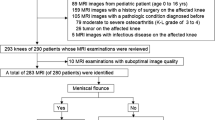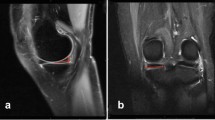Abstract
Purpose
Obesity is a worldwide pandemic; however, no adaptations were made to the physical examination of obese patient’s knees. The accuracy of the physical examination is critical for correct assessment and selection of treatment. We aimed to assess whether body mass index (BMI) affects the sensitivity and specificity of common provocative knee tests.
Methods
We studied 210 patients who underwent knee arthroscopy to treat anterior cruciate ligament (ACL) and meniscal pathologies. BMI and the knee’s physical examination were documented pre-operatively. Sensitivity, specificity, and accuracy of ACL and meniscal provocative tests in relation to BMI were evaluated using arthroscopy as a gold standard.
Results
The Anterior Drawer, Lachman, and Pivot-Shift tests for ACL tears were significantly less accurate and sensitive, yet more specific, in obese patients when compared to normal and overweight patients. The McMurray, Apley Grind, and Thessaly tests for medial meniscus tears showed greater sensitivity, but lower specificity, in patients with increased BMI. Above normal BMIs, independently of age and gender, were significantly associated with higher odds for positive ACL tests.
Conclusion
Tests for ACL tears are less sensitive in obese patients and alternatives to the classic tests should be considered. Medial meniscus tests tend to be more sensitive and less specific in patients with greater BMIs. Their results should be carefully interpreted due to possible false positives. The physician should take into consideration the impact of patient BMI on the accuracy of their physical examination of the knee to optimize treatment decision-making.


Similar content being viewed by others
Data availability
The authors declare data is available per request.
References
WHO (2012) Obesity and overweight. https://www.who.int/en/news-room/fact-sheets/detail/obesity-and-overweight. Accessed 2 Jan 2021
Silk AW (2011) Reexamining the physical examination for obese patients. JAMA 305:193. https://doi.org/10.1001/jama.2010.1950
Elbaz A, Debbi EM, Segal G et al (2011) Sex and body mass index correlate with Western Ontario and McMaster Universities Osteoarthritis Index and quality of life scores in knee osteoarthritis. Arch Phys Med Rehabil 92:1618–1623. https://doi.org/10.1016/j.apmr.2011.05.009
Hung A, Sayre EC, Guermazi A et al (2016) Association of body mass index with incidence and progression of knee effusion on magnetic resonance imaging and on knee examination. Arthritis Care Res 68:511–516. https://doi.org/10.1002/acr.22714
Salih S, Sutton P (2013) Obesity, knee osteoarthritis and knee arthroplasty: a review. BMC Sports Sci Med Rehabil 5:1–6
Bojicic KM, Beaulieu ML, Imaizumi Krieger DY et al (2017) Association between lateral posterior tibial slope, body mass index, and ACL injury risk. Orthop J Sport Med 5.https://doi.org/10.1177/2325967116688664
Walker JL, Hosseinzadeh P, White H et al (2019) Idiopathic genu valgum and its association with obesity in children and adolescents. J Pediatr Orthop 39:347–352. https://doi.org/10.1097/BPO.0000000000000971
Draper DO (1990) A comparison of stress tests used to evaluate the anterior cruciate ligament. Phys Sportsmed 18:89–96. https://doi.org/10.1080/00913847.1990.11709953
Draper DO, Schulthies SS (1995) Examiner proficiency in performing the Anterior Drawer and Lachman tests. J Orthop Sports Phys Ther 22:263–266. https://doi.org/10.2519/jospt.1995.22.6.263
Achtnich A, Petersen W, Willinger L et al (2018) Medial meniscus extrusion increases with age and BMI and is depending on different loading conditions. Knee Surgery, Sport Traumatol Arthrosc 26:2282–2288. https://doi.org/10.1007/s00167-018-4885-7
Vajapey SP, Miller TL (2021) Clinical tests used to diagnose anterior cruciate ligament tears are less sensitive in obese patients: a retrospective cohort study. Curr Orthop Pract 32:6–10. https://doi.org/10.1097/BCO.0000000000000943
Malanga GA, Andrus S, Nadler SF, McLean J (2003) Physical examination of the knee: a review of the original test description and scientific validity of common orthopedic tests. Arch Phys Med Rehabil 84:592–603. https://doi.org/10.1053/apmr.2003.50026
de Oliveira FCL, Roy JS, Pappas E (2020) ACL injury, physical activity, and overweight/obesity: a vicious cycle? Knee Surgery. Sport Traumatol Arthrosc 28:667–669
Anandacoomarasamy A, Caterson I, Sambrook P et al (2008) The impact of obesity on the musculoskeletal system. Int J Obes 32:211–222
Abate M, Salini V, Andia I (2016) How obesity affects tendons? Advances in Experimental Medicine and Biology. Springer, New York LLC, pp 167–177
Ursini F, Naty S, Grembiale RD (2011) Fibromyalgia and obesity: the hidden link. Rheumatol Int 31:1403–1408
Author information
Authors and Affiliations
Contributions
RG conceived the study, designed and coordinated it, received institutional board approval, collected materials, and drafted the manuscript. IM carried out the statistical analysis, drafted the manuscript, reported the results, discussed their interpretation, and designed the tables and illustrations. AM collected data and drafted the original manuscript. AL collected data and drafted the original manuscript. OC carried out the statistical analysis and edited and reviewed the final version. DL assisted in study design and editing and review of the manuscript. YB assisted in study conception and supervision, edited and reviewed the final version. AG assisted in study conception and supervision, edited and reviewed the final version.
Corresponding author
Ethics declarations
Ethical approval
Institutional review board approval was obtained prior to study initiation.
Consent to participate
Informed consent was not required for this study as per institutional review board approval.
Consent for publication
Informed consent was not required for this study as per institutional review board approval.
Conflict of interest
The authors declare no competing interests.
Additional information
Publisher's note
Springer Nature remains neutral with regard to jurisdictional claims in published maps and institutional affiliations.
Rights and permissions
About this article
Cite this article
Gilat, R., Mitchnik, I.Y., Moriah, A. et al. The impact of body mass index on the accuracy of the physical examination of the knee. International Orthopaedics (SICOT) 46, 831–836 (2022). https://doi.org/10.1007/s00264-021-05277-x
Received:
Accepted:
Published:
Issue Date:
DOI: https://doi.org/10.1007/s00264-021-05277-x




